人教版(2019)选择性必修 第二册Unit 1 Science and Scientists Listening and Speaking 课件(共19张PPT,内镶嵌音频)
文档属性
| 名称 | 人教版(2019)选择性必修 第二册Unit 1 Science and Scientists Listening and Speaking 课件(共19张PPT,内镶嵌音频) | 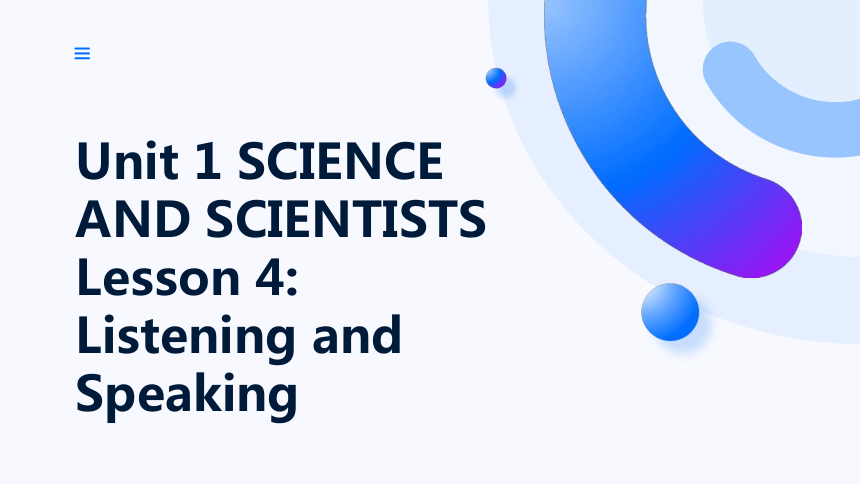 | |
| 格式 | pptx | ||
| 文件大小 | 13.6MB | ||
| 资源类型 | 教案 | ||
| 版本资源 | 人教版(2019) | ||
| 科目 | 英语 | ||
| 更新时间 | 2025-03-02 14:43:09 | ||
图片预览


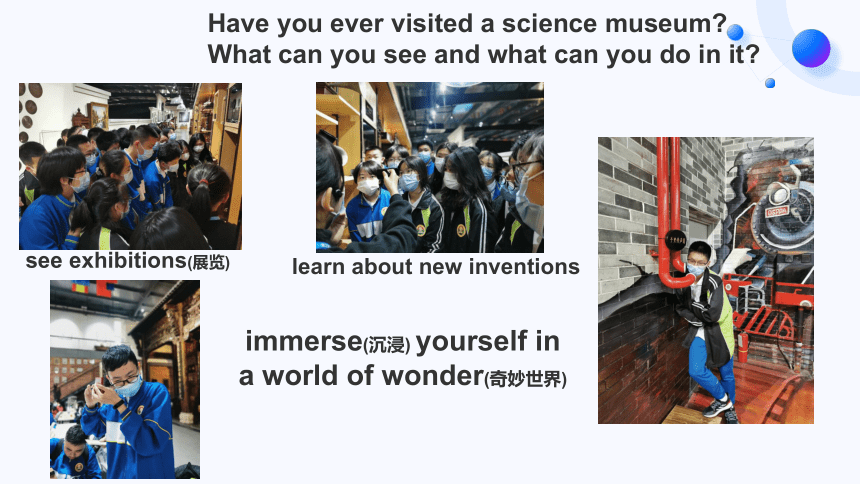
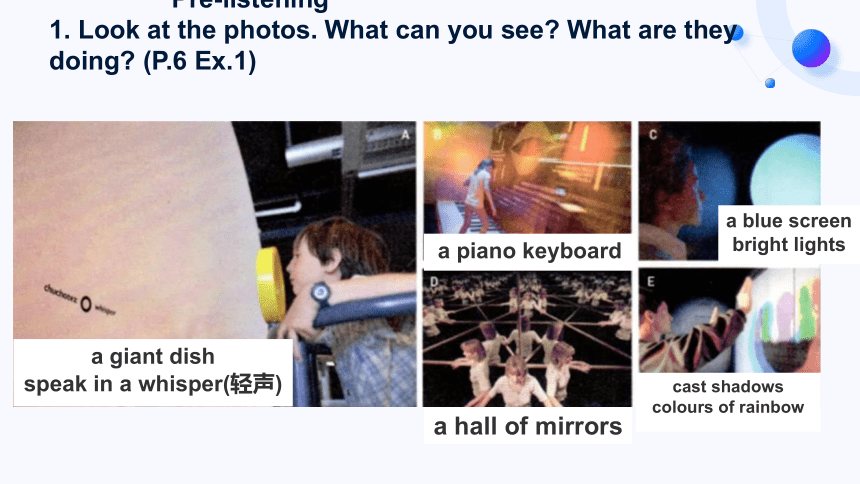
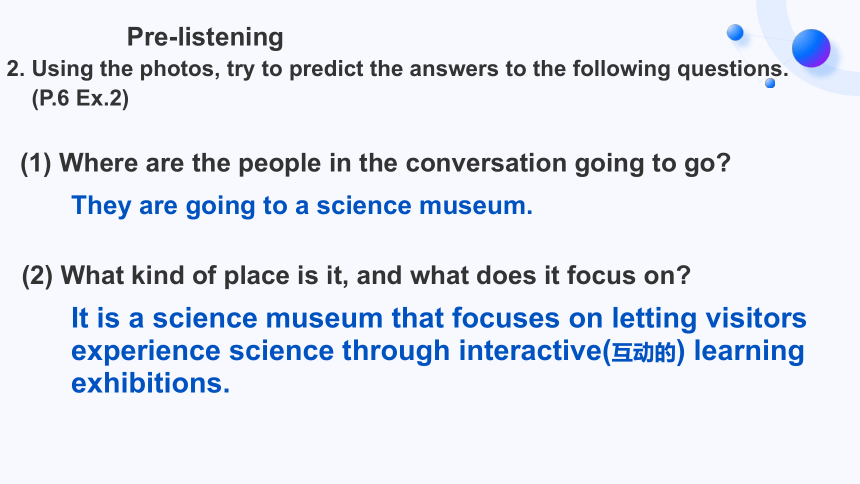
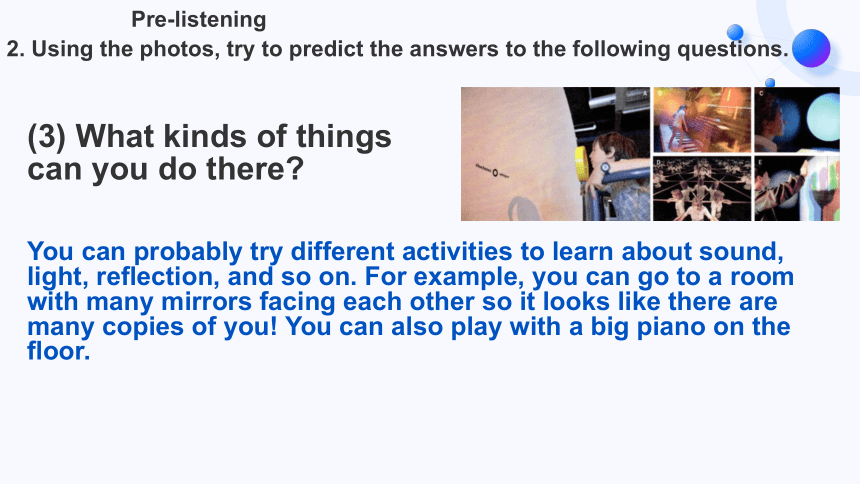
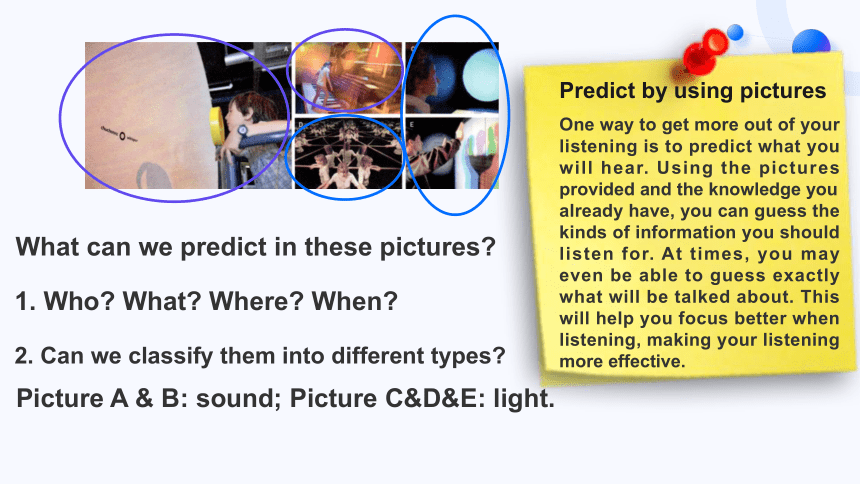
文档简介
(共19张PPT)
Unit 1 SCIENCE AND SCIENTISTS
Lesson 4: Listening and Speaking
After this lesson, you will be able to
1
predict by using pictures to focus better when listening
2
3
listen and understand what people can do and how they feel in a science museum
talk about a scientific experience or a scientific phenomenon in daily life
Learning objectives
Have you ever visited a science museum
What can you see and what can you do in it
see exhibitions(展览)
immerse(沉浸) yourself in a world of wonder(奇妙世界)
learn about new inventions
a giant dish
speak in a whisper(轻声)
a piano keyboard
a blue screen
bright lights
a hall of mirrors
cast shadows
colours of rainbow
Pre-listening
1. Look at the photos. What can you see What are they doing (P.6 Ex.1)
Pre-listening
2. Using the photos, try to predict the answers to the following questions.
(P.6 Ex.2)
(1) Where are the people in the conversation going to go
(2) What kind of place is it, and what does it focus on
They are going to a science museum.
It is a science museum that focuses on letting visitors experience science through interactive(互动的) learning exhibitions.
Pre-listening
2. Using the photos, try to predict the answers to the following questions.
(3) What kinds of things can you do there
You can probably try different activities to learn about sound, light, reflection, and so on. For example, you can go to a room with many mirrors facing each other so it looks like there are many copies of you! You can also play with a big piano on the floor.
Predict by using pictures
One way to get more out of your listening is to predict what you will hear. Using the pictures provided and the knowledge you already have, you can guess the kinds of information you should listen for. At times, you may even be able to guess exactly what will be talked about. This will help you focus better when listening, making your listening more effective.
What can we predict in these pictures
1. Who What Where When
2. Can we classify them into different types
Picture A & B: sound; Picture C&D&E: light.
While-listening
1. Listen to the conversation and see if your answers for Activity 2 are correct. Then write down the letters (A-E) for the photos in the order that you hear them described. (P.6 Ex.3) TIP: Try to note down the key phrases.
1. _____
2. _____
3. _____
4. _____
5. _____
light games
a hall of mirrors
a blue screen
tiny bright lights
cast shadows
colours of rainbow
an area for sound
a piano keyboard
a giant dish
speak in a whisper
D
C
E
B
A
Located in Paris, France, the City of Science and Industry is the biggest science museum in Europe. The goal of the City is to spread scientific and technical knowledge among the public, particularly the youth, and to promote public interest in science, research and industry. Attractions include a planetarium, a submarine, an IMAX theatre and special areas for children and teenagers, where games, interactive exhibits, and experimental areas allow them to really get their thinking caps on to explore.
Cultural Note: the City of Science and Industry
n. 天文馆/,pl n ’te ri m/
n. 潜艇
/,s bm ’ri n/
开动脑筋
图片来源于网络
While-listening
2. Listen again and complete the descriptions of the photos. (P.6 Ex.4)
Photo A: A giant dish; when you speak into it, it __________ the sound back and
_______________. You can use it to speak in a _________ to someone 17 meters away.
Photo B: A giant ______________ that you can use your feet to play. Instead of playing the
sounds of a piano, it plays the voices of________________.
Photo C: You look at a blue screen for a while, and then suddenly you can see
________________ moving around on it. These are our_________________.
Photo D: A ________________ where you can see yourself reflected thousands of times.
Photo E: You stand in front of _____________ and it casts different shadows of you,
in ___________________ the rainbow.
reflects
makes it louder
whisper
piano keyboard
classical singers
tiny bright lights
own blood cells
hall of mirrors
a white light
every colour of
Post-listening
1. Answer the following questions about science museums. (P.7 Ex.5)
The conversation is about the City of Science and Industry, a museum
in Paris. Would you like to go to this museum Why or why not
(2) Are there any museums like this in China What can
you do in them
Yes, because the exhibitions seem really interesting. I think I would learn a lot about science and it can broaden my horizons(开拓视野).
Yes. For example, there is the China Science and Technology Museum (中国科学技术馆) in Beijing and the Guangdong Science Center (广东科学中心) in Guangzhou. We can do many interesting experiments in such museums.
图片来源于网络
图片来源于网络
Post-listening
2. Brainstorm and talk about a scientific experiment you are interested in.
TIP: You can refer to the sentence patterns provided. (P.7 Ex.6)
1.Opening: Today, I want to talk to you about a very strange phenomenon called a non-Newtonian fluid(非牛顿流体).
2.Materials needed: You can make it easily using equal parts of water and cornflour(矢车菊), like I have here.
3.Process: A non-Newtonian fluid is strange because you can pour it like a liquid, but if you put any pressure on it, it suddenly becomes hard as concrete(混凝土). In fact, it becomes hard enough to stand on. Then, as soon as you take the pressure off, it becomes a liquid again.
4.Theory: This shows that it is possible that something can exist as a liquid and a solid at the same time.
Talking about scientific phenomena
.. can/cannot exist in the form of a solid/gas and a liquid/plasma(血浆).
... is both a ... and a.. . at the same time …
how light/sound is reflected …
This occurs when ...
If you ..., it will become ...
That demonstrates(表明) ...
This experiment/research shows ...
Through this, we know that ....
We can prove that ...
This evidence proves …
In addition to the science museums, where else can people have scientific experiences
图片来源于网络
图片来源于网络
in space
in a science museum
That demonstrates zero gravity magnifies the surface tension of water in space.
This experiment shows…
Through this, we know that ...
This occurs when things are in zero gravity.
Wang placed the flower bud folded with paper on the water film.
Wang created a water film using a metal ring and a bag filled with water.
The bud rotated magically on the film and “blossomed”.
Theory
Materials needed
Process
图片来源于网络
图片来源于网络
图片来源于网络
Post-listening
Make a presentation about the “Water Film Experiment”.
1. Opening: Today, I want to talk to you about a very interesting phenomenon and I learnt about it from the “Water Film Experiment”[Name] in the Tiangong space station.
2. Experimenter: Wang Yaping, a Chinese female astronaut, did a scientific experiment with a flower bud which she and her daughter folded with paper before the space journey.
3. Materials needed: First, she created a water film using a metal ring and a bag filled with water.
4. Process: Then, she placed the flower bud on the water film. The amazing thing was that the bud rotated magically on the film and “blossomed”!
5. Theory: This occurs when things are in zero gravity. This experiment shows that zero gravity magnifies the surface tension of water in space.
Review of new words
cast /kɑ st/ v. 投射;向……投以(视线、笑容等);投掷
reflect /r flekt/ v. 反射(声、光、热等);反映(影像)
pour /p (r)/ v. 倒出,倾泻,斟(饮料)
whisper / w sp (r)/ v./n. 耳语;低语;私语;小声说
exhibition / eks b ( )n/ n. 展览,展出
shadow / d / n. 阴影,影子,背光处
rainbow / re nb / n. 彩虹
concrete / k kri t/ n. 混凝土 adj. 混凝土制的;确实的;具体的
solid / s l d/ adj. 可靠的,固体的,坚实的 n. 固体
plasma / pl zm / n. 血浆
In addition to the science museums and space, where else can people have scientific experiences
图片来源于网络
图片来源于网络
in space
in a science museum
in daily life
图片来源于网络
Homework
Talk about a scientific phenomenon in your daily life.
temperature / tempr t (r)/ (n.)温度
humidity /hju m d ti/ (n.)湿度
moisture / m st (r)/ (n.)水分
condense /k n dens/ (v.)冷凝
Word Bank
图片来源于网络
Eg. Have you ever seen a foggy window
of a car When does it happen Why
Homework
Talk about a scientific phenomenon in your daily life.
(Please refer to the example of “Water Film Experiment”.)
Think about the function of science and what students can do
with scientific knowledge.
Finish the vocabulary exercises related to scientific experiences.
Unit 1 SCIENCE AND SCIENTISTS
Lesson 4: Listening and Speaking
After this lesson, you will be able to
1
predict by using pictures to focus better when listening
2
3
listen and understand what people can do and how they feel in a science museum
talk about a scientific experience or a scientific phenomenon in daily life
Learning objectives
Have you ever visited a science museum
What can you see and what can you do in it
see exhibitions(展览)
immerse(沉浸) yourself in a world of wonder(奇妙世界)
learn about new inventions
a giant dish
speak in a whisper(轻声)
a piano keyboard
a blue screen
bright lights
a hall of mirrors
cast shadows
colours of rainbow
Pre-listening
1. Look at the photos. What can you see What are they doing (P.6 Ex.1)
Pre-listening
2. Using the photos, try to predict the answers to the following questions.
(P.6 Ex.2)
(1) Where are the people in the conversation going to go
(2) What kind of place is it, and what does it focus on
They are going to a science museum.
It is a science museum that focuses on letting visitors experience science through interactive(互动的) learning exhibitions.
Pre-listening
2. Using the photos, try to predict the answers to the following questions.
(3) What kinds of things can you do there
You can probably try different activities to learn about sound, light, reflection, and so on. For example, you can go to a room with many mirrors facing each other so it looks like there are many copies of you! You can also play with a big piano on the floor.
Predict by using pictures
One way to get more out of your listening is to predict what you will hear. Using the pictures provided and the knowledge you already have, you can guess the kinds of information you should listen for. At times, you may even be able to guess exactly what will be talked about. This will help you focus better when listening, making your listening more effective.
What can we predict in these pictures
1. Who What Where When
2. Can we classify them into different types
Picture A & B: sound; Picture C&D&E: light.
While-listening
1. Listen to the conversation and see if your answers for Activity 2 are correct. Then write down the letters (A-E) for the photos in the order that you hear them described. (P.6 Ex.3) TIP: Try to note down the key phrases.
1. _____
2. _____
3. _____
4. _____
5. _____
light games
a hall of mirrors
a blue screen
tiny bright lights
cast shadows
colours of rainbow
an area for sound
a piano keyboard
a giant dish
speak in a whisper
D
C
E
B
A
Located in Paris, France, the City of Science and Industry is the biggest science museum in Europe. The goal of the City is to spread scientific and technical knowledge among the public, particularly the youth, and to promote public interest in science, research and industry. Attractions include a planetarium, a submarine, an IMAX theatre and special areas for children and teenagers, where games, interactive exhibits, and experimental areas allow them to really get their thinking caps on to explore.
Cultural Note: the City of Science and Industry
n. 天文馆/,pl n ’te ri m/
n. 潜艇
/,s bm ’ri n/
开动脑筋
图片来源于网络
While-listening
2. Listen again and complete the descriptions of the photos. (P.6 Ex.4)
Photo A: A giant dish; when you speak into it, it __________ the sound back and
_______________. You can use it to speak in a _________ to someone 17 meters away.
Photo B: A giant ______________ that you can use your feet to play. Instead of playing the
sounds of a piano, it plays the voices of________________.
Photo C: You look at a blue screen for a while, and then suddenly you can see
________________ moving around on it. These are our_________________.
Photo D: A ________________ where you can see yourself reflected thousands of times.
Photo E: You stand in front of _____________ and it casts different shadows of you,
in ___________________ the rainbow.
reflects
makes it louder
whisper
piano keyboard
classical singers
tiny bright lights
own blood cells
hall of mirrors
a white light
every colour of
Post-listening
1. Answer the following questions about science museums. (P.7 Ex.5)
The conversation is about the City of Science and Industry, a museum
in Paris. Would you like to go to this museum Why or why not
(2) Are there any museums like this in China What can
you do in them
Yes, because the exhibitions seem really interesting. I think I would learn a lot about science and it can broaden my horizons(开拓视野).
Yes. For example, there is the China Science and Technology Museum (中国科学技术馆) in Beijing and the Guangdong Science Center (广东科学中心) in Guangzhou. We can do many interesting experiments in such museums.
图片来源于网络
图片来源于网络
Post-listening
2. Brainstorm and talk about a scientific experiment you are interested in.
TIP: You can refer to the sentence patterns provided. (P.7 Ex.6)
1.Opening: Today, I want to talk to you about a very strange phenomenon called a non-Newtonian fluid(非牛顿流体).
2.Materials needed: You can make it easily using equal parts of water and cornflour(矢车菊), like I have here.
3.Process: A non-Newtonian fluid is strange because you can pour it like a liquid, but if you put any pressure on it, it suddenly becomes hard as concrete(混凝土). In fact, it becomes hard enough to stand on. Then, as soon as you take the pressure off, it becomes a liquid again.
4.Theory: This shows that it is possible that something can exist as a liquid and a solid at the same time.
Talking about scientific phenomena
.. can/cannot exist in the form of a solid/gas and a liquid/plasma(血浆).
... is both a ... and a.. . at the same time …
how light/sound is reflected …
This occurs when ...
If you ..., it will become ...
That demonstrates(表明) ...
This experiment/research shows ...
Through this, we know that ....
We can prove that ...
This evidence proves …
In addition to the science museums, where else can people have scientific experiences
图片来源于网络
图片来源于网络
in space
in a science museum
That demonstrates zero gravity magnifies the surface tension of water in space.
This experiment shows…
Through this, we know that ...
This occurs when things are in zero gravity.
Wang placed the flower bud folded with paper on the water film.
Wang created a water film using a metal ring and a bag filled with water.
The bud rotated magically on the film and “blossomed”.
Theory
Materials needed
Process
图片来源于网络
图片来源于网络
图片来源于网络
Post-listening
Make a presentation about the “Water Film Experiment”.
1. Opening: Today, I want to talk to you about a very interesting phenomenon and I learnt about it from the “Water Film Experiment”[Name] in the Tiangong space station.
2. Experimenter: Wang Yaping, a Chinese female astronaut, did a scientific experiment with a flower bud which she and her daughter folded with paper before the space journey.
3. Materials needed: First, she created a water film using a metal ring and a bag filled with water.
4. Process: Then, she placed the flower bud on the water film. The amazing thing was that the bud rotated magically on the film and “blossomed”!
5. Theory: This occurs when things are in zero gravity. This experiment shows that zero gravity magnifies the surface tension of water in space.
Review of new words
cast /kɑ st/ v. 投射;向……投以(视线、笑容等);投掷
reflect /r flekt/ v. 反射(声、光、热等);反映(影像)
pour /p (r)/ v. 倒出,倾泻,斟(饮料)
whisper / w sp (r)/ v./n. 耳语;低语;私语;小声说
exhibition / eks b ( )n/ n. 展览,展出
shadow / d / n. 阴影,影子,背光处
rainbow / re nb / n. 彩虹
concrete / k kri t/ n. 混凝土 adj. 混凝土制的;确实的;具体的
solid / s l d/ adj. 可靠的,固体的,坚实的 n. 固体
plasma / pl zm / n. 血浆
In addition to the science museums and space, where else can people have scientific experiences
图片来源于网络
图片来源于网络
in space
in a science museum
in daily life
图片来源于网络
Homework
Talk about a scientific phenomenon in your daily life.
temperature / tempr t (r)/ (n.)温度
humidity /hju m d ti/ (n.)湿度
moisture / m st (r)/ (n.)水分
condense /k n dens/ (v.)冷凝
Word Bank
图片来源于网络
Eg. Have you ever seen a foggy window
of a car When does it happen Why
Homework
Talk about a scientific phenomenon in your daily life.
(Please refer to the example of “Water Film Experiment”.)
Think about the function of science and what students can do
with scientific knowledge.
Finish the vocabulary exercises related to scientific experiences.
